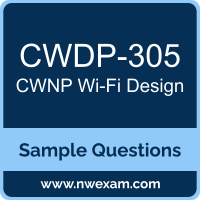01. Which DHCP option, when required, should be configured and enabled to help APs locate their wireless LAN controller?
a) 150
b) 62
c) 43
d) 22
02. What is the most suitable antenna option to be used when designing a WLAN infrastructure with APs mounted on a ceiling with a height of more than 20 feet and having all of the client stations used from the floor?
a) Low-gain dipole
b) Grid
c) Dish
d) Patch
03. When installing APs on high ceilings, what should be the most common PPE to be used?
a) Hardhat, high visibility vest and body belt
b) Clean suits, masks and glasses
c) Glasses, gloves and jacket
d) Clean suits, gloves and jacket
04. Your customer requires fast secure roaming. Which two types of roaming are specified in 802.11-2016 FT roaming that will help meet this goal?
a) Over-the-Air and Over-the-DS
b) FT and TKIP
c) Over-the-Air and Over-the-Wire
d) FT and OKC
05. A museum wants to offer Wi-Fi to its visitors. One of their requirements is to have the APs blend into the design of the museum. What should you do to meet this requirement?
a) Lock the AP inside of a metal box
b) Use a plastic cover that could blend in with the environment
c) Use an 802.11b AP, so it looks old enough to be in a museum
d) Place the APs in between walls and I-beams
06. What kind of site survey helps you identify if roaming is working as designed?
a) Passive
b) Predictive
c) Active
d) Spectrum analysis walkthrough
07. Using a SCA means that all APs will be using the same channel in a given layer. How is the AP with which the client associates determined?
a) The client selects the AP based on a known set of MAC to BSSID mappings stored in the clients authorized SSID listing.
b) All APs share a virtual IP address. A controller will tell the closest AP to the client to communicate with it, since it has a greater RSSI from the client.
c) All APs share a virtual BSSID. A controller will tell the closest AP to the client to communicate with it, since it has a greater RSSI from the client.
d) All APs share a virtual Multicast Address. A controller will tell the closest AP to the client to communicate with it, since it has a greater RSSI from the client.
08. During your first pre-deployment meeting with the deployment team, you hand out the full design documentation to all of them. What's your primary goal during this meeting?
a) To explain how Wi-Fi works.
b) To explain design decisions and ensure understanding of design documents.
c) To discuss AP functionality.
d) To justify the budget.
09. When designing a static channel plan for an office using voice devices near an airport, which range of channels should be avoided to ensure optimal performance when implemented?
a) 1-11
b) 36-40
c) 116-124
d) 44-48
10. Who should be in the final meeting from the customer-side after successfully implementing a WLAN infrastructure?
a) Remote workers
b) CEO or CFO
c) The customer's customers
d) End-users
 Before you write the CWNP Wi-Fi Design (CWDP-305) certification exam, you may have certain doubts in your mind regarding the pattern of the test, the types of questions asked in it, the difficulty level of the questions and time required to complete the questions. These CWNP Certified Wireless Design Professional (CWDP) sample questions and demo exam help you in removing these doubts and prepare you to take the test.
Before you write the CWNP Wi-Fi Design (CWDP-305) certification exam, you may have certain doubts in your mind regarding the pattern of the test, the types of questions asked in it, the difficulty level of the questions and time required to complete the questions. These CWNP Certified Wireless Design Professional (CWDP) sample questions and demo exam help you in removing these doubts and prepare you to take the test.